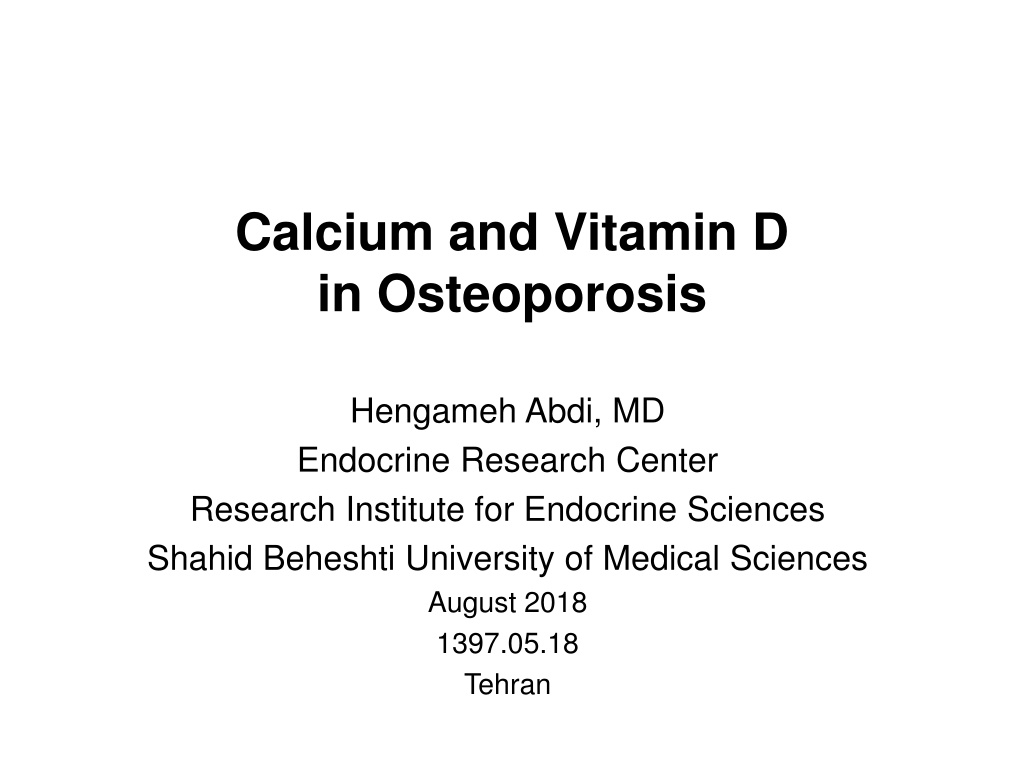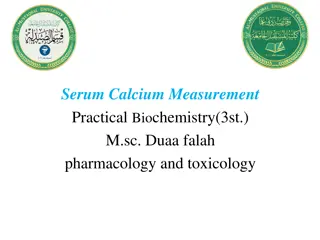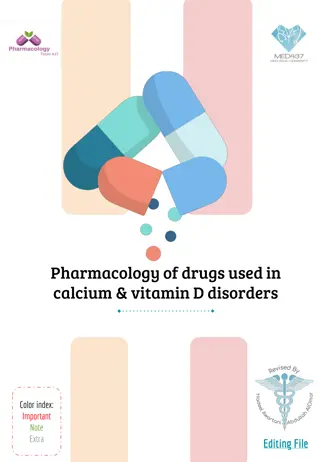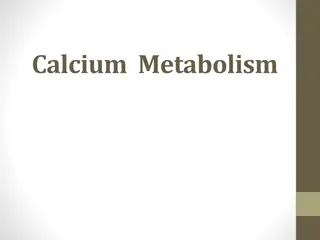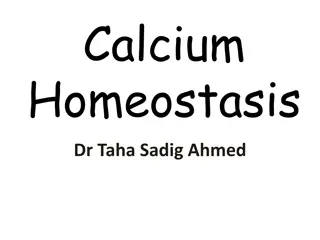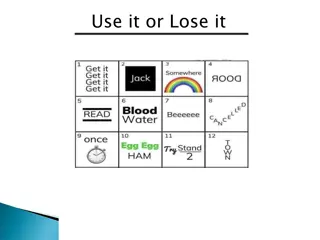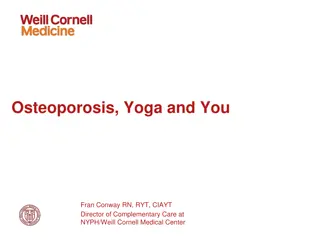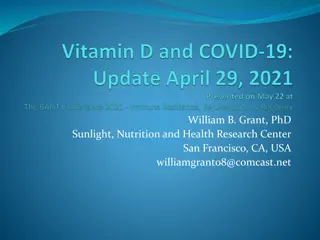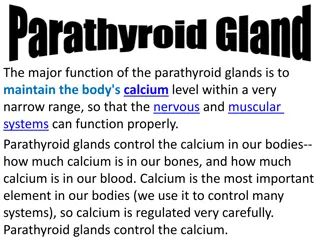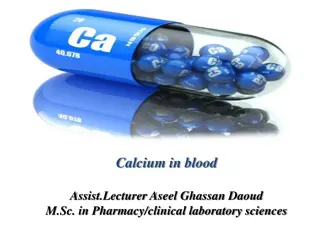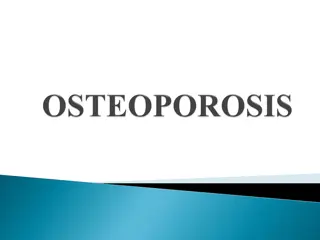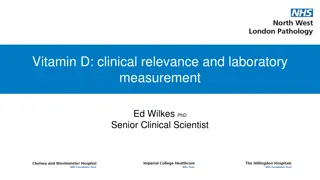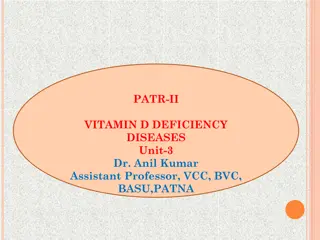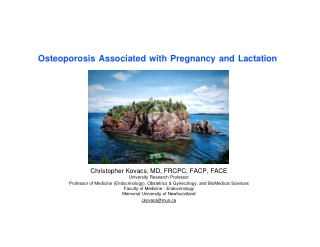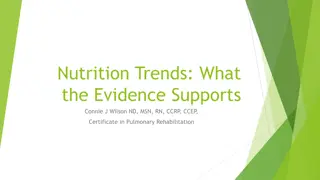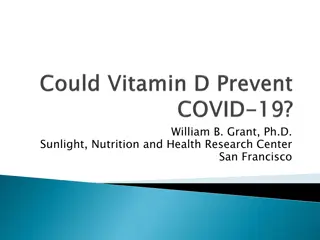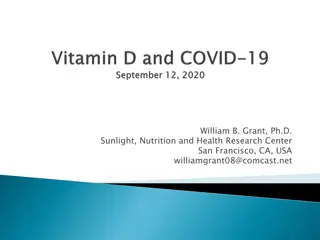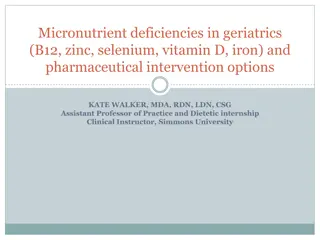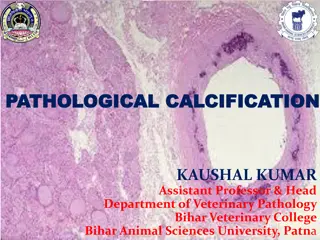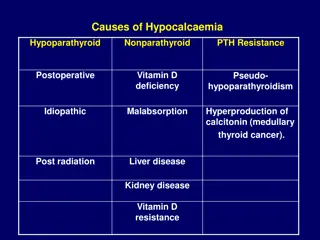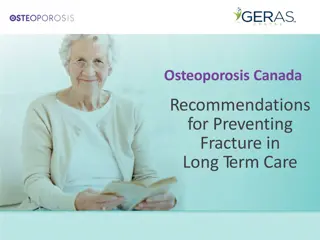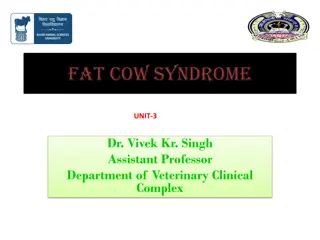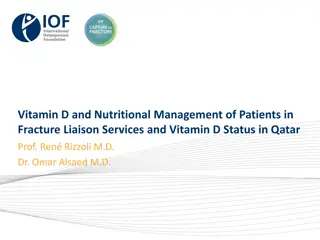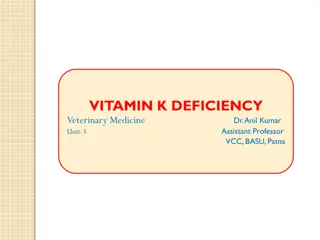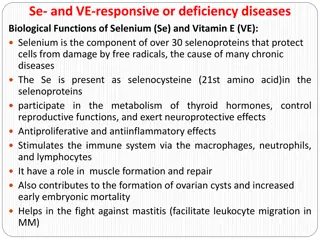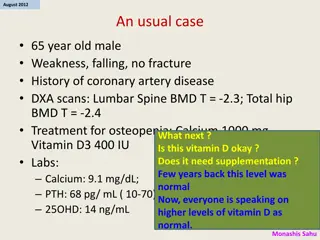Update on Calcium and Vitamin D Supplementation in Osteoporosis
The study reviews the benefits and risks of calcium and vitamin D supplementation for bone health. It discusses the impact on bone loss, fracture prevention, fall prevention, and cardiovascular risks. Evidence suggests that increasing calcium intake may have limited effects on bone mineral density and fracture risk, while the efficacy of calcium supplements in fracture prevention is inconclusive. The study also assesses the role of combined vitamin D and calcium supplementation in fracture prevention, highlighting the need for further research in this area.
Download Presentation

Please find below an Image/Link to download the presentation.
The content on the website is provided AS IS for your information and personal use only. It may not be sold, licensed, or shared on other websites without obtaining consent from the author. Download presentation by click this link. If you encounter any issues during the download, it is possible that the publisher has removed the file from their server.
E N D
Presentation Transcript
Calcium and Vitamin D in Osteoporosis Hengameh Abdi, MD Endocrine Research Center Research Institute for Endocrine Sciences Shahid Beheshti University of Medical Sciences August 2018 1397.05.18 Tehran
Agenda Introduction Overview of the most recent update on benefits and harms of calcium/vitamin D supplementation Calcium and/or vitamin D and bone loss/fracture prevention Vitamin D with and without calcium and fall prevention Cardiovascular risk of calcium/vitamin D supplementation Conclusions
Guideline recommendations on calcium and vitamin D intake for prevention and treatment of osteoporosis Grey A, Bolland M. BMJ 2015;351:h3170.
Calcium intake, bone mineral density (BMD) and risk of fracture Increasing calcium intake from dietary sources or by taking calcium supplements produces small non- progressive increases in BMD, which are unlikely to lead to a clinically significant reduction in risk of fracture. Dietary calcium intake is not associated with risk of fracture, and there is no clinical trial evidence that increasing calcium intake from dietary sources prevents fractures. Evidence that calcium supplements prevent fractures is weak and inconsistent. Tai V, et al. BMJ 2015;351:h4183. Bolland MJ, et al. BMJ 2015;351:h4580.
Objective: To update the evidence for benefits and harms of vitamin D, calcium, or combined supplementation for the primary prevention of fractures in community-dwelling adults to inform the US Preventive Services Task Force. Study selection: English-language randomized clinical trials (RCTs) or observational studies of supplementation with vitamin D, calcium, or both among adult populations; studies of populations that were institutionalized or had known vitamin D deficiency, osteoporosis, or prior fracture were excluded. Main outcomes: Incident fracture, cardiovascular events, and cancer. mortality, kidney stones, Kahwati LC, et al. JAMA 2018;319(15):1600-1612.
8 RCTs 9 RCTs Kahwati LC, et al. JAMA 2018;319(15):1600-1612.
No decreased fracture risk over 3-7 years Low strength of evidence
Supplementation using vitamin D with calcium was associated with an increased incidence of kidney stones. Low to moderate strength of evidence
Other outcomes: Strength of evidence: Low or insufficient Supplementation with vitamin D alone or with calcium had no significant effect on all-cause mortality, incident cardiovascular disease or incident cancer.
Limitations: This supplementation in higher-risk, selected populations. review cannot address the effect of Although some evidence on men exists, the majority of this body of evidence is applicable to postmenopausal, white women. Only a few studies evaluated vitamin D doses > 800 IU per day, and the evidence on calcium was limited to doses ranging from 400 mg to 1600 mg per day.
Key messages: Vitamin D supplementation alone or with calcium was not associated with reduced fracture incidence among community-dwelling adults aged 50 years without known vitamin D deficiency, osteoporosis, or prior fracture. Vitamin D with calcium was associated with an increase in the incidence of kidney stones. Kahwati LC, et al. JAMA 2018;319(15):1600-1612.
Objective: To investigate whether calcium, vitamin D, or combined calcium and vitamin D supplements are associated with a lower fracture incidence in community-dwelling older adults. Study selection: Randomized clinical trials comparing calcium, vitamin D, or combined calcium and vitamin D supplements with a placebo or no treatment for fracture incidence in community-dwelling adults > 50 years. Main outcomes: Primary: Hip fracture Secondary: Nonvertebral fracture, vertebral fracture, and total fracture Zhao JG, et al. JAMA 2017;318(24):2466-2482.
Key messages: There was no significant association of calcium or vitamin D or combined calcium and vitamin D with risk of hip, nonvertebral, vertebral, or total fractures compared with placebo or no treatment. Subgroup analyses showed that these results were generally consistent regardless of the calcium or vitamin D dose, sex, fracture history, dietary calcium intake, and baseline serum 25-hydroxyvitamin D concentration. Zhao JG, et al. JAMA 2017;318(24):2466-2482.
Objective: To explore the value of doing further randomised controlled trials (RCTs) assessing the effects of vitamin D supplements on falls with trial sequential analysis with a risk reduction threshold of 15%. Twenty RCTs were included. Bolland MJ, et al. Lancet Diabetes Endocrinol 2014;2:573-80.
Supplementation with vitamin D, with or without calcium, had no effect on falls.
Key messages: Supplementation with vitamin D, with or without calcium, had no effect on falls in traditional meta-analysis. Trial sequential analysis suggests that vitamin D supplementation, with or without calcium, does not decrease falls by 15% or more. Future trials with similar designs are unlikely to alter these conclusions. At present, there is little justification for prescribing vitamin D supplements to prevent falls. Bolland MJ, et al. Lancet Diabetes Endocrinol 2014;2:573-80.
Objective: To investigate the effects of personal calcium supplement use on cardiovascular risk in the Women s Health Initiative Calcium/Vitamin D Supplementation Study (WHI CaD Study), using the WHI dataset, and to update the recent meta-analysis of calcium supplements and cardiovascular risk. Main outcomes: Incidence of four cardiovascular events and their combinations (myocardial infarction, coronary revascularization, death from coronary heart disease, and stroke). Bolland MJ, et al. BMJ 2011;342:d2040.
WHI CaD Study: Design: Randomized, placebo controlled trial Participants: 36,282 community dwelling postmenopausal women Intervention: Ca-VD (1g/400 IU) Duration: Average of 7 yr Primary endpoint: Hip fracture Secondary endpoints: Total fracture Colorectal cancer
Effect of allocation to calcium and vitamin D supplement on cardiovascular events among participants in the WHI CaD Study In the 16,718 women (46%) who were not taking personal calcium supplements at randomization, HR for cardiovascular events with Ca-VD: Clinical MI: 1.22 (1.00-1.50), P=0.05 Clinical MI or stroke: 1.16 (1.00-1.35), P=0.05 Clinical MI or revascularization: 1.16 (1.01-1.34), P=0.04 In women taking personal calcium supplements: Cardiovascular risk did not alter with allocation to Ca-VD.
Meta-analysis Effect of calcium supplements with or without vitamin D on cardiovascular events: based on patient-level data (5 trials of Ca supplements and WHI CaD Study participants not taking personal Ca) Bolland MJ, et al. BMJ 2011;342:d2040.
Interpretation of results Comparisons of the benefits of calcium on fracture prevention with the risk of cardiovascular events: The risk to benefit profile is unfavourable. Treating 1000 patients with calcium or calcium and vitamin D for five years would cause an additional six myocardial infarctions or strokes and prevent only three fractures! (NNH=178, NNT=302)
Key messages: Calcium supplements with or without vitamin D modestly increase the risk of cardiovascular events, especially myocardial infarction, a finding obscured in the WHI CaD Study by the widespread use of personal calcium supplements. A reassessment of the role of calcium supplements in osteoporosis management is warranted. Bolland MJ, et al. BMJ 2011;342:d2040.
Objective: To address the effects of calcium intake (from dietary or supplemental sources), alone or in combination with vitamin D, on CVD risk in generally healthy adults. Study selection: Randomized trials (4) and prospective cohort (26) and nested case-control (1) studies. Cardiovascular disease outcomes were secondary end points in all RCTs. Chung M, et al. Ann Intern Med 2016 doi:10.7326/M16-1165.
Key messages: Calcium intake (from either food or supplement sources) at levels within the recommended tolerable upper intake range (2000 to 2500 mg/d) are not associated with CVD risks in generally healthy adults. Chung M, et al. Ann Intern Med 2016 doi:10.7326/M16-1165.
Take home messages: Controversies regarding both the possible usefulness for bone health (benefit) and the potential harmful effects (risk) of calcium and/or vitamin D supplementation are continued. Evidence is insufficient to assess the balance of the benefits and harms of vitamin D and calcium supplementation, alone or combined, for the primary prevention of fractures in men and premenopausal women (USPSTF I statement).
Take home messages: Evidence is insufficient to assess the balance of the benefits and harms of daily supplementation with doses > 400 IU of vitamin D and > 1000 mg of calcium for the primary prevention of fractures in community-dwelling, postmenopausal women (USPSTF I statement). The supplementation with 400 IU of vitamin D and 1000 mg of calcium for the primary prevention of fractures in community-dwelling, postmenopausal women (D). USPSTF recommends against daily
Take home messages: A reasonable current approach is to preferentially encourage dietary calcium intake and discourage the routine use of calcium supplements.
